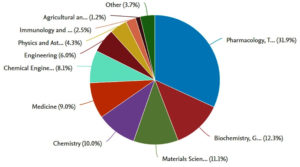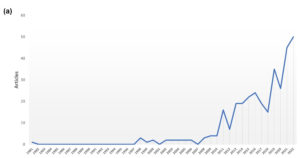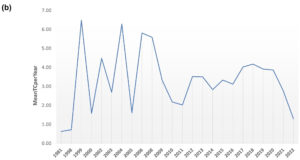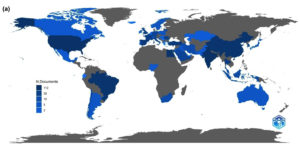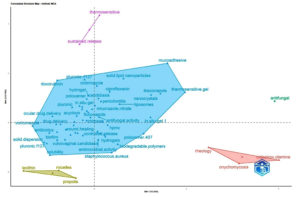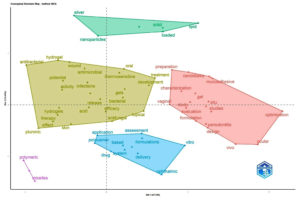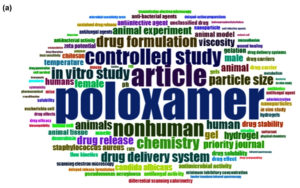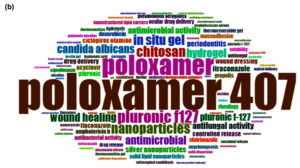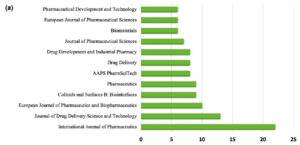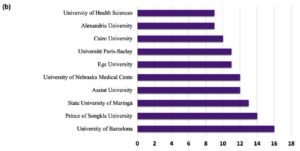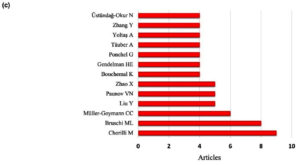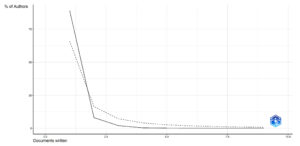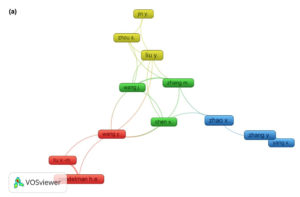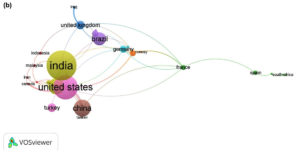ISSN: 0973-7510
E-ISSN: 2581-690X
Infectious diseases caused by pathogenic microorganisms pose significant threats to public health globally. The emergence of antibiotic-resistant bacteria has further complicated the treatment of these infections, necessitating the exploration of alternative therapeutic strategies. Among these strategies, the use of hydrogels as delivery systems for delivering antimicrobial agents has gained considerable attention. This paper presents a comprehensive bibliometric analysis of the utilization of Pluronic F-127 (PF-127) hydrogel for delivering antimicrobial agents. The aim of this study is to explore the current research landscape, identify key trends, influential authors, and prominent journals in this field. The analysis is based on a systematic search conducted using the Scopus database. The analysis covered publication trends, geographic distribution, influential authors, and key journals in the field of PF-127 hydrogel-based antimicrobial agent delivery. The results revealed the growing interest in this field, with a focus on countries such as India, the United States, and Egypt. The analysis also identified top authors, institutions, and journals contributing to the research. The findings reveal the growth of research in this area, highlighting the potential of PF-127 hydrogel as a promising vehicle for antimicrobial agent delivery. It highlights the need for further research to optimize formulation parameters, explore combination therapies, conduct in vivo studies, and promote collaboration to maximize the therapeutic potential of PF-127 hydrogel-based delivery systems in combating infectious diseases and antimicrobial resistance. This paper provides valuable insights into the existing literature and serves as a reference for future research and development in the field.
Poloxamer 407, Research Trends, PF-127, Scopus Database, Thermoresponsive Hydrogel, Antimicrobial Agent, Antibacterial Activity
Infectious diseases caused by pathogenic microorganisms pose significant threats to public health globally. The use of antimicrobial agents is essential in addressing the challenges posed by infectious diseases and antimicrobial resistance.1 However, the effectiveness of these agents is often limited by factors such as poor bioavailability, rapid clearance, and the emergence of resistant strains. The emergence of antibiotic-resistant bacteria has further complicated the treatment of these infections, necessitating the exploration of alternative therapeutic strategies. Among these strategies, the use of hydrogels as delivery systems for antimicrobial agents has gained considerable attention.2 Hydrogels offer a three-dimensional (3D) network capable of encapsulating and releasing drugs in a controlled and sustained manner.2 Pluronic F-127 (PF-127) hydrogel, in particular, has emerged as a promising candidate due to its unique properties and potential to combat microbial infections.3
PF-127 hydrogel has emerged as a promising vehicle for delivering antimicrobial agents in various biomedical applications. It is a block copolymer composed of poly(ethylene oxide) (PEO) and poly(propylene oxide) (PPO) segments.4 This amphiphilic nature of PF-127 enables it to self-assemble into micelles at low temperatures and undergo sol-gel transition at physiological temperatures.5 This transition behavior has been extensively exploited in drug delivery applications, as it allows for convenient gelation at room temperature, facilitating ease of administration. The unique properties of PF-127, including its thermosensitivity, biocompatibility, and ability to sol-gel transition, make it an attractive choice for controlled and sustained release of antimicrobial agents.6,7 This hydrogel system offers several advantages, such as localized drug delivery, prolonged drug release, and the ability to create an optimal environment for wound healing while combating infections.8 PF-127 hydrogel lacks intrinsic antimicrobial activity against Staphylococcus aureus and Escherichia coli, but its antiadhesive properties and biocompatibility make it a promising neutral carrier system for antibiotics and antimicrobial compounds in biomedical applications.7 Its antiadhesive properties indirectly contribute to preventing microbial infections by inhibiting bacterial adhesion. PF-127 hydrogel reduces the likelihood of bacterial colonization and subsequent infection.9
PF-127 hydrogel provides a promising solution by encapsulating and releasing antimicrobial agents in a controlled manner, thereby maximizing their therapeutic potential.4 Understanding the interplay between the hydrogel and the loaded agents is crucial for optimizing the therapeutic efficacy and ensuring controlled release profiles.10 A deeper understanding of the release mechanisms will aid in the design and development of hydrogel-based delivery systems with tailored release profiles for specific.11
This paper aims to provide a comprehensive overview of the current state of research on PF-127 hydrogel for delivering antimicrobial agents. It encompasses a bibliometric analysis using the Scopus database to explore publication trends, geographic distribution, influential authors, and key journals in this field. Understanding the literature landscape and the advancements made in PF-127 hydrogel-based antimicrobial agent delivery will enable researchers to identify knowledge gaps, potential areas for further investigation, and emerging trends in the field. Moreover, this analysis will facilitate collaboration and knowledge sharing among researchers, leading to accelerated advancements and the development of more effective strategies for antimicrobial agent delivery. The present study explores the current research landscape, identify key trends, influential authors, and prominent journals associated with evaluating the potential of PF-127 as a carrier of antimicrobial agents.
Search strategy and data collection
The literature search was performed on May 23, 2023, using the Scopus database. The search strategy aimed to collect data on journal articles published until 2022 while excluding certain publication types such as reviews, editorials, conference papers, book chapters, books, letters, notes, short surveys, erratum, reports, and retracted papers. Only articles published in English were considered, excluding publications in other languages. The following search query was employed:
TITLE-ABS-KEY ( ( poloxamer 407 OR “Pluronic F-127” OR pf-127 OR pluronic-f-127 OR “Pluronic™ F-127” OR “Plutonic F127” OR pf127 OR “Pluronic® F-127” OR “Pluronic® F127” ) AND ( antibiotic* OR antimicrobial* OR antifungal* OR antiviral* OR anti-biofilm ) ) AND ( LIMIT-TO ( DOCTYPE, “ar” ) ) AND ( LIMIT-TO ( LANGUAGE, “English” ) ) AND ( LIMIT-TO ( SRCTYPE, “j” ) ) AND ( EXCLUDE ( PUBYEAR, 2023 ) )
By employing the above search strategy, a focused and comprehensive dataset of journal articles related to Pluronic F-127 hydrogel for delivering antimicrobial agents was obtained, adhering to the specified criteria for publication type, language, and publication year. This search query focuses on articles that mention the specific term “Pluronic F-127” and its modifications in conjunction with different keywords corresponding to different antimicrobial agents. The use of the operator “OR” broadens the search to include different variants of PF-127 and antimicrobial agents.
Analysis of variables and visualization
The metadata was analyzed using R Studio and the bibliometrix package, which is a powerful open-source tool specifically designed for conducting comprehensive science mapping analysis within the R statistical programming language.12 The extracted data was further analyzed and interpretation was done under the following titles: overview of publication trends, geographic distribution of research, most cited articles, analysis of keywords, identification of top authors and institutes, identification of influential journals, and evaluation of collaboration networks. In addition, the data was visualized using network visualization software VOSviewer (version 1.6.17).13
Scopus offers a vast collection of scholarly literature, including journals, conference papers, patents, and book series, from various disciplines. It covers a wide range of subject areas, making it suitable for multidisciplinary research.14 Web of Science might have limited coverage of literature, particularly in some emerging or specialized fields. However, this can be due to the fact that Web of Science maintains strict inclusion criteria, ensuring the quality and reliability of the indexed publications.15 This database is renowned for its rigorous selection process, which minimizes the risk of including low-quality or predatory journals in the analysis.14,15 It is important to note that both Scopus and Web of Science have their strengths and weaknesses when it comes to bibliometric analysis. Researchers should consider their specific research needs, disciplinary focus, and intended analysis goals while selecting the most appropriate database for their bibliometric studies.
Overview of Publication Trends
This paper provides a comprehensive overview of research on PF-127 hydrogel for delivering antimicrobial agents, covering a period from 1981 to 2022 (Table 1). The analysis is based on 161 sources (journals) resulting in a total of 325 documents. The field has shown an annual growth rate of 10.01%. The average age of the documents is 6.31 years, while the average number of citations per document is 23.02. The collected data includes a total of 13,643 references. The document contents consist of 3,354 keywords Plus and 1,023 author’s keywords. In total, there are 1,678 authors associated with these documents, and 4 of the documents are single-authored. The collaboration among authors shows an average of 5.96 co-authors per document, with international co-authorships accounting for 20% of the total.
Table (1):
Basic characteristics of the analyzed data on Pluronic F-127 hydrogel research for delivering antimicrobial agents.
| Description | Results |
|---|---|
| Main information | |
| Timespan | 1981:2022 |
| Sources (Journals, Books, etc.) | 161 |
| Documents | 325 |
| Annual growth rate % | 10.01 |
| Document average age | 6.31 |
| Average citations per doc | 23.02 |
| References | 13643 |
| Document contents | |
| Keywords Plus (ID) | 3354 |
| Author’s keywords (DE) | 1023 |
| Authors | |
| Authors | 1678 |
| Authors of single-authored docs | 4 |
| Authors collaboration | |
| Single-authored docs | 4 |
| Co-authors per doc | 5.96 |
| International co-authorships % | 20 |
| Document types | |
| Article | 325 |
The subject areas under which articles in Pluronic F-127 hydrogel research for delivering antimicrobial agents are classified in the Scopus database are illustrated in Figure 1. The major subject areas include Pharmacology, Toxicology and Pharmaceutics1 (92 documents), Biochemistry, Genetics and Molecular Biology (74), Materials Science (67), Chemistry (60), Medicine (54), Chemical Engineering (49), Engineering (36), Physics and Astronomy (26), Immunology and Microbiology (15), Agricultural and Biological Sciences (7), Dentistry (7) to name a few. Line diagram illustrating the publication trend of articles in Pluronic F-127 hydrogel research for delivering antimicrobial agents from 1981 to 2022 is inserted as Figure 2. In addition, the line diagram illustrating the mean total citations per year (MeanTCperYear) is inserted as Figure 2.
Figure 1. Pie chart illustrating the subject areas under which articles in Pluronic F-127 hydrogel research for delivering antimicrobial agents are classified in the Scopus database
Figure 2. (a) Line diagram illustrating the publication trend of articles in Pluronic F-127 hydrogel research for delivering antimicrobial agents from 1981 to 2022. (b) Line diagram illustrating the mean total citations per year (MeanTCperYear) of articles published from 1981 to 2022
Geographic Distribution of Research
Scientific production on the use of Pluronic F-127 hydrogel for delivering antimicrobial agents varies across different countries (Figure 3). India has the highest number of articles with 112 publications, followed closely by the United States with 107 articles. Egypt has contributed 85 articles, while Brazil and China have 83 and 82 articles, respectively. Spain has published 51 articles, Turkey 49, and Thailand 42. France and the United Kingdom have comparatively lower numbers of publications, with 33 and 31 articles, respectively, on this topic. The map representing Country Scientific Production (worldwide data) is inserted as Figure 3a. The map illustrating the country collaboration analysis is inserted as Figure 3b. The USA was found to be the country with the broadest collaboration network which includes active scientific relationships with 16 other countries. This was followed by India and United Kingdom as second and third active scientific collaborations (8 and 7 countries).
Figure 3. (a) Map representing Country Scientific Production across the globe. (b) Map illustrating the country collaboration analysis
Most Cited Articles
The characteristics of the top ten most cited papers in Pluronic F-127 hydrogel research for delivering antimicrobial agents are given in Table 2. Among the 10 papers, three highly cited papers were published in the International Journal of Pharmaceutics, Two each in AAPS PharmSciTech journal and Journal of Controlled Release. In addition, one paper was published in Journal of Nanoparticle Research, European Journal of Pharmaceutical Sciences and Drug Delivery Journal.
Table (2):
Characteristics of the top ten most cited papers in Pluronic F-127 hydrogel research for delivering antimicrobial agents.
No. |
Paper |
Total Citations |
TC per Year |
Normalized TC |
|---|---|---|---|---|
1 |
Kelly HM, Deasy PB, Ziaka E, et al. Formulation and preliminary in vivo dog studies of a novel drug delivery system for the treatment of periodontitis. Int J Pharm. 2004 Apr 15;274(1-2):167-83. doi: 10.1016/j.ijpharm.2004.01.019. PMID: 15072793. |
184 |
9.20 |
1.47 |
2 |
Veyries ML, Couarraze G, Geiger S, et al. Controlled release of vancomycin from poloxamer 407 gels. Int J Pharm. 1999 Dec 10;192(2):183-93. doi: 10.1016/s0378-5173(99)00307-5. PMID: 10567749. |
162 |
6.48 |
1.00 |
3 |
Dinge A, Nagarsenker M. Formulation and evaluation of fast dissolving films for delivery of triclosan to the oral cavity. AAPS PharmSciTech. 2008;9(2):349-56. doi: 10.1208/s12249-008-9047-7. Epub 2008 Feb 15. PMID: 18431674; PMCID: PMC2976960. |
156 |
9.75 |
1.75 |
4 |
Chang JY, Oh YK, Kong HS, et al. Prolonged antifungal effects of clotrimazole-containing mucoadhesive thermosensitive gels on vaginitis. J Control Release. 2002 Jul 18;82(1):39-50. doi: 10.1016/s0168-3659(02)00086-x. PMID: 12106975. |
149 |
6.77 |
1.51 |
5 |
Bilensoy E, Rouf MA, Vural I, et al. Mucoadhesive, thermosensitive, prolonged-release vaginal gel for clotrimazole:beta-cyclodextrin complex. AAPS Pharmscitech. 2006 Apr;7(2):E38. DOI: 10.1208/pt070238. PMID: 16796356; PMCID: PMC2750286. |
130 |
7.22 |
1.24 |
6 |
Liu Y, Zhu YY, Wei G, et al. Effect of carrageenan on poloxamer-based in situ gel for vaginal use: Improved in vitro and in vivo sustained-release properties. Eur J Pharm Sci. 2009 Jun 28;37(3-4):306-12. doi: 10.1016/j.ejps.2009.02.022. Epub 2009 Mar 14. PMID: 19491020. |
125 |
8.33 |
2.51 |
7 |
Mou D, Chen H, Wan J, et al. Potent dried drug nanosuspensions for oral bioavailability enhancement of poorly soluble drugs with pH-dependent solubility. Int J Pharm. 2011 Jul 15;413(1-2):237-44. doi: 10.1016/j.ijpharm.2011.04.034. Epub 2011 Apr 21. PMID: 21540090. |
117 |
9.00 |
4.45 |
8 |
Bromberg L, Alakhov V. Effects of polyether-modified poly(acrylic acid) microgels on doxorubicin transport in human intestinal epithelial Caco-2 cell layers. J Control Release. 2003 Feb 14;88(1):11-22. doi: 10.1016/s0168-3659(02)00419-4. PMID: 12586499. |
105 |
5.00 |
1.86 |
9 |
Chudasama B, Vala AK, Andhariya N, et al. Highly bacterial resistant silver nanoparticles: synthesis and antibacterial activities. Journal of Nanoparticle Research. 2010 Jun;12:1677-85. |
103 |
7.36 |
3.38 |
10 |
El-Housiny S, Shams Eldeen MA, El-Attar YA, et al. Fluconazole-loaded solid lipid nanoparticles topical gel for treatment of pityriasis versicolor: formulation and clinical study. Drug Deliv. 2018 Nov;25(1):78-90. doi: 10.1080/10717544.2017.1413444. Erratum in: Drug Deliv. 2018 Nov;25(1):2015. PMID: 29239242; PMCID: PMC6058711. |
102 |
17.00 |
4.08 |
The salient findings of the top 10 most cited papers in Pluronic F-127 hydrogel research for delivering antimicrobial agents are as follows:
- A drug delivery system for periodontitis treatment was developed using tetracycline-loaded halloysite coated with chitosan. Poloxamer 407 was used as a thermoresponsive polymer, with the gelling temperature modified by PEG 20,000.16
- Poloxamer 407 25% (w/w) formulations were developed to prolong the residence time of vancomycin for high-risk infection sites. The formulations underwent reversible thermal gelation upon injection, maintaining the rheological properties and antibacterial activity of vancomycin. Poloxamer 407 shows promise as a vancomycin delivery vehicle for local infection prophylaxis, particularly in prosthetic surgery.17
- Triclosan (TC) fast dissolving films for oral delivery were formulated using poloxamer 407. The addition of poloxamer 407 and hydroxypropyl-β-cyclodextrin (HPBCD) enhanced TC solubility. Films with TC-Poloxamer 407 showed improved dissolution profile and antimicrobial activity compared to TC-HPBCD complex films.18
- Mucoadhesive thermosensitive gels containing clotrimazole were developed for vaginal candidiasis treatment. Formulations with poloxamers 407, 188, and polycarbophil (PC) showed enhanced mucoadhesiveness.19
- Clotrimazole (1%) was complexed with beta-cyclodextrin to enhance solubility and achieve controlled release. The gel formulation with clotrimazole:beta-cyclodextrin (1%:1) in Pluronic F127 (20%) with hydroxypropylmethylcellulose (0.2%) exhibited prolonged release above MIC values, offering potential for enhanced therapeutic efficacy and patient compliance.20
- Carrageenan was found to enhance the sustained-release properties of poloxamer 407-based vaginal in situ gel. It reduced the release rate of acyclovir, slowed gel erosion, and prolonged drug residence locally. The combination of carrageenan and poloxamer 407 holds promise for the development of improved vaginal drug delivery systems with prolonged local residence and enhanced clinical outcomes.21
- Dried nanosuspensions of itraconazole (ITZ) were prepared using poloxamer 407 or HPMC as stabilizers. The spray-dried ITZ nanosuspensions showed preserved high dissolution rates. This formulation may be a promising approach to enhance the oral bioavailability of poorly soluble drugs with pH-dependent solubility.22
- Microgels composed of cross-linked copolymers of poly(acrylic acid) and Pluronics, specifically Pluronic L61, L92, and F127, were evaluated as permeation enhancers for doxorubicin transport in Caco-2 cell monolayers. The microgels inhibited P-glycoprotein-mediated efflux and enhanced the passive influx of doxorubicin, resulting in increased cell absorption.23
- A rapid synthesis route using oleylamine was employed to produce uniform hydrophobic silver nanoparticles. Pluronic F127 was utilized for phase transfer to enhance dispersal in water. The hydrophilic silver nanoparticles showed excellent antimicrobial activity against various bacteria, surpassing commercially available antibacterial agents.24
- This study aimed to enhance the topical delivery of Fluconazole (FLZ) for treating Pityriasis Versicolor (PV) by formulating FLZ-loaded solid lipid nanoparticles (SLNs) topical gel. The use of Poloxamer 407 as a stabilizer in SLNs resulted in smaller particle size compared to other surfactants.25
Analysis of Keywords
The Multiple Correspondence Analysis (MCA) was employed to analyze the keywords in our dataset. It condenses vast data with multiple variables into a reduced-dimensional space, creating a visually informative two-dimensional (or three-dimensional) graph. The graph utilizes the distance between points on the plane to represent the similarity between keywords. Keywords that approach the center point indicate a higher level of attention in recent. The interpretation of the results is based on the positions of the points and their distribution along the dimensions. The closer words are represented on the map, the more similar their distribution is years.26 The conceptual structure analysis of the top 50 keywords Plus, author keywords, and keywords in titles is given in Figure 4. The top 50 keywords Plus were divided into five clusters: Cluster 1 (anti-bacterial agents, anti-infective agent), Cluster 2 (human, drug effect, humans, chemistry), Cluster 3 (drug carriers, animal, male, female, gels, hydrogel, unclassified drug, priority journal, drug carrier, animals), Cluster 4 (animal tissue, animal model, animal experiment, in vivo study), and the remaining were clubbed as Cluster 5. Similarly, the top 50 author keywords and keywords in titles were clustered into five groups as given in Figure 5 and 6.
The WordCloud illustrating the top 100 most frequent Keywords Plus is given as Figure 7a. The general terms such as poloxamer (450), article (262), nonhuman (195), controlled study (191), chemistry (142), and in vitro study (139), were the top five most frequent Keywords Plus identified in this study. Similarly, Figure 7b presents the WordCloud of top 100 authors keywords used in their publications. Among the identified keywords, the highest occurrences include poloxamer 407 (51), poloxamer (28), pluronic f127 (17), chitosan (15), nanoparticles (15), in situ gel (14), and antimicrobial (12).
Figure 7. WordCloud illustrating the top 100 most frequent Keywords Plus (a) and 100 most frequent words by authors keywords (b).
Identification of Top Authors and Institutes
Bar diagram illustrating the top productive authors publishing articles in Pluronic F-127 hydrogel research for delivering antimicrobial agents is inserted as Figure 8. According to Lotka’s law, 1494 authors (89.03%) among the total 1678 identified are considered occassional authors whereas 48 authors were identified as the core authors (who published ≥3 articles in the present case). Lotka’s law characterizes the distribution of authorship in a specific field, stating that the frequency of authors publishing a certain number of articles follows an approximate inverse-square relationship. According to Lotka’s law, the ratio of authors who publish a specific number of articles to the number of authors who publish only one article remains relatively constant. Additionally, Lotka’s law confirms that as the number of articles published increases, authors who produce that many publications become less common (Figure 9).
Figure 8. (a) Bar diagram illustrating the top journals publishing articles in Pluronic F-127 hydrogel research for delivering antimicrobial agents. (b) Bar diagram illustrating the top productive universities/institutes publishing articles in Pluronic F-127 hydrogel research for delivering antimicrobial agents. (c) Bar diagram illustrating the top productive authors publishing articles in Pluronic F-127 hydrogel research for delivering antimicrobial agents
Bar diagram illustrating the top productive universities/institutes publishing articles in Pluronic F-127 hydrogel research for delivering antimicrobial agents is inserted as Figure 8. Among the 541 entries of universities/institutes identified, the following were selected as the most productive: University of Barcelona, Prince of Songkla University, State University of Maringá, Assiut University, University of Nebraska Medical Cente, Ege University, Université Paris-Saclay, Cairo University, Alexandria University, and University of Health Sciences.
Identification of Influential Journals
The top journals publishing articles in Pluronic F-127 hydrogel research for delivering antimicrobial agents included International Journal of Pharmaceutics (22 documents), Journal of Drug Delivery Science and Technology (13), European Journal of Pharmaceutics and Biopharmaceutics (10), Colloids and Surfaces B: Biointerfaces (9), Pharmaceutics (9), AAPS PharmSciTech (8), Drug Delivery (8), Drug Development and Industrial Pharmacy (8), Journal of Pharmaceutical Sciences (7), Biomaterials (6), European Journal of Pharmaceutical Sciences (6), and Pharmaceutical Development and Technology (6) (Figure 8).
Among the 161 journal (sources) that published 325 documents, 12 journals (International Journal of Pharmaceutics, Journal of Drug Delivery Science and Technology, European Journal of Pharmaceutics and Biopharmaceutics, Colloids and Surfaces B: Biointerfaces, Pharmaceutics, AAPS PharmSciTech, Drug Delivery, Drug Development and Industrial Pharmacy, Journal of Pharmaceutical Sciences, Biomaterials, European Journal of Pharmaceutical Sciences, and Pharmaceutical Development and Technology) were included in the Zone 1 of the three zones. These Zone 1 journals together published 112 articles of the total 325 (34.46%). According to the Bradford’s law, Zone 1 is considered the nucleus (core zone) of journals particularly devoted to the given subject.
Evaluation of Collaboration Networks
The network visualization map indicating the connections between authors and countries. Specifically, authors and countries with a minimum of three documents were selected for inclusion in the map. Although 43 authors met this threshold, some of them were not connected and therefore the largest set of connected items constituting of 12 authors were illustrated (Figure 10). Similarly, 27 countries of the total 29 countries that met the threshold were illustrated since they formed the largest network (Figure 10). The size of each circle/frame in the map represents the total number of published articles, with larger circles indicating a higher publication count. On the other hand, the width of the lines in the map signifies the strength of the links, with wider lines indicating stronger connections. The distance between two circles in the map reflects the degree of relatedness between the corresponding nodes.27
Figure 10 The network visualization map indicating the connections between authors and countries. Specifically, authors with a minimum of three documents (a) and countries with a minimum of three documents (b) were selected for inclusion in the map. The size of each circle/frame in the map represents the total number of published articles, with larger circles indicating a higher publication count. On the other hand, the width of the lines in the map signifies the strength of the links, with wider lines indicating stronger connections. The distance between two circles in the map reflects the degree of relatedness between the corresponding nodes
PF-127 hydrogel holds significant potential for delivering antimicrobial agents. Through a comprehensive bibliometric analysis, this paper has provided insights into the current research landscape, key trends, influential authors, and prominent journals in this field. The findings highlight the growing interest in PF-127 hydrogel as a versatile platform for antimicrobial agent delivery. Future research should focus on addressing the remaining challenges, optimizing formulation parameters, exploring combination therapies, conducting in vivo studies, and promoting collaboration to realize the full potential of Pluronic F-127 hydrogel-based delivery systems in clinical applications. The insights gained from this analysis will contribute to the development of innovative approaches for combating infections and addressing the growing threat of antimicrobial resistance.
ACKNOWLEDGMENTS
The authors would like to thank Director, ICAR-Indian Veterinary Research Institute, Izatnagar, Bareilly, India, and the All-India Network Program on Diagnostic Imaging and Management of Surgical Conditions in Animals (AINP-DIMSCA) for providing the necessary research facilities to carry out this work.
CONFLICT OF INTEREST
The authors declare that there is no conflict of interest.
AUTHORS’ CONTRIBUTION
All authors listed have made a substantial, direct and intellectual contribution to the work, and approved it for publication.
FUNDING
None.
DATA AVAILABILITY
All datasets generated or analyzed during this study are included in the manuscript.
ETHICS STATEMENT
Not applicable.
- Llor C, Bjerrum L. Antimicrobial resistance: risk associated with antibiotic overuse and initiatives to reduce the problem. Ther Adv Drug Saf. 2014;5(6):229-241.
Crossref - Li J, Mooney DJ. Designing hydrogels for controlled drug delivery. Nat Rev Mater. 2016;1(12):16071.
Crossref - Yu S, Sun H, Li Y, Wei S, Xu J, Liu J. Hydrogels as promising platforms for engineered living bacteria-mediated therapeutic systems. Mater Today Bio. 2022;16:100435.
Crossref - Dumortier G, Grossiord JL, Agnely F, Chaumeil JC. A review of poloxamer 407 pharmaceutical and pharmacological characteristics. Pharm Res. 2006;23(12):2709-2728.
Crossref - Chatterjee S, Hui PC, Kan CW, Wang W. Dual-responsive (pH/temperature) Pluronic F-127 hydrogel drug delivery system for textile-based transdermal therapy. Sci Rep. 2019;9(1):11658.
Crossref - Lupu A, Rosca I, Gradinaru VR, Bercea M. Temperature Induced Gelation and Antimicrobial Properties of Pluronic F127 Based Systems. Polymers (Basel). 2023;15(2):355.
Crossref - Sharun K, Nair SS, Banu SA, et al. In vitro Antimicrobial Properties of Pluronic F-127 Injectable Thermoresponsive Hydrogel. J Pure Appl Microbiol. 2023;17(2):1231-1237.
Crossref - Katas H, Wen CY, Siddique MI, Hussain Z, Mohd Fadhil FH. Thermoresponsive curcumin/DsiRNA nanoparticle gels for the treatment of diabetic wounds: synthesis and drug release. Ther Deliv. 2017;8(3):137-150.
Crossref - Muszanska AK, Rochford ET, Gruszka A, et al. Antiadhesive polymer brush coating functionalized with antimicrobial and RGD peptides to reduce biofilm formation and enhance tissue integration. Biomacromolecules. 2014;15(6):2019-2026.
Crossref - Khattak SF, Bhatia SR, Roberts SC. Pluronic F127 as a cell encapsulation material: utilization of membrane-stabilizing agents. Tissue Eng. 2005;11(5-6):974-983.
Crossref - Yang K, Han Q, Chen B, et al. Antimicrobial hydrogels: promising materials for medical application. Int J Nanomed. 2018;13:2217-2263.
Crossref - Aria M, Cuccurullo C. Bibliometrix: an R-tool for comprehensive science mapping analysis. J Inf. 2017;11(4):959-975.
Crossref - van Eck NJ, Waltman L. Software survey: VOSviewer, a computer program for bibliometric mapping. Scientometrics. 2010;84(2):523-538.
Crossref - Martin-Martin A, Orduna-Malea E, Thelwall M, Lopez-Cozar ED. Google Scholar, Web of Science, and Scopus: A systematic comparison of citations in 252 subject categories. J Informetr. 2018 1;12(4):1160-1177.
Crossref - Martin-Martin A, Thelwall M, Orduna-Malea E, Delgado Lopez-Cozar E. Google Scholar, Microsoft Academic, Scopus, Dimensions, Web of Science, and OpenCitations’ COCI: a multidisciplinary comparison of coverage via citations. Scientometrics. 2021;126(1):871-906.
Crossref - Kelly HM, Deasy PB, Ziaka E, Claffey N. Formulation and preliminary in vivo dog studies of a novel drug delivery system for the treatment of periodontitis. Int J Pharm. 2004;274(1-2):167-183.
Crossref - Veyries ML, Couarraze G, Geiger S, et al. Controlled release of vancomycin from poloxamer 407 gels. Int J Pharm. 1999;192(2):183-193.
Crossref - Dinge A, Nagarsenker M. Formulation and evaluation of fast dissolving films for delivery of triclosan to the oral cavity. AAPS Pharm Sci Tech. 2008;9(2):349-356.
Crossref - Chang JY, Oh YK, Kong HS, et al. Prolonged antifungal effects of clotrimazole-containing mucoadhesive thermosensitive gels on vaginitis. J Control Release. 2002;82(1):39-50.
Crossref - Bilensoy E, Rouf MA, Vural I, Sen M, Hincal AA. Mucoadhesive, thermosensitive, prolonged-release vaginal gel for clotrimazole:beta-cyclodextrin complex. AAPS Pharm Sci Tech. 2006;7(2):E38.
Crossref - Liu Y, Zhu YY, Wei G, Lu WY. Effect of carrageenan on poloxamer-based in situ gel for vaginal use: Improved in vitro and in vivo sustained-release properties. Eur J Pharm Sci. 2009;37(3-4):306-312.
Crossref - Mou D, Chen H, Wan J, Xu H, Yang X. Potent dried drug nanosuspensions for oral bioavailability enhancement of poorly soluble drugs with pH-dependent solubility. Int J Pharm. 2011;413(1-2):237-244.
Crossref - Bromberg L, Alakhov V. Effects of polyether-modified poly(acrylic acid) microgels on doxorubicin transport in human intestinal epithelial Caco-2 cell layers. J Control Release. 2003;88(1):11-22.
Crossref - Chudasama B, Vala AK, Andhariya N, Mehta RV, Upadhyay RV. Highly bacterial resistant silver nanoparticles: synthesis and antibacterial activities. J Nanopart Res. 2010;12:1677-1685.
Crossref - El-Housiny S, Shams Eldeen MA, El-Attar YA, Salem HA, Attia D, Bendas ER, El-Nabarawi MA. Fluconazole-loaded solid lipid nanoparticles topical gel for treatment of pityriasis versicolor: formulation and clinical study. Drug Deliv. 2018;25(1):78-90.
Crossref - Xie H, Zhang Y, Wu Z, Lv T. A bibliometric analysis on land degradation: Current status, development, and future directions. Land. 2020;9(1):28.
Crossref - Sharun K, Musa TH, Musa HH, et al. Mapping global trends in adipose-derived mesenchymal stem cell research: A bibliometric analysis using scopus database. Ann Med Surg (Lond). 2022 14;77:103542.
Crossref
© The Author(s) 2023. Open Access. This article is distributed under the terms of the Creative Commons Attribution 4.0 International License which permits unrestricted use, sharing, distribution, and reproduction in any medium, provided you give appropriate credit to the original author(s) and the source, provide a link to the Creative Commons license, and indicate if changes were made.



